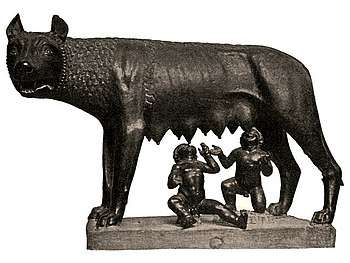Fur farming
Fur farming is the practice of breeding or raising certain types of animals for their fur.
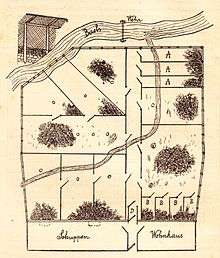
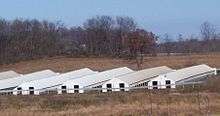
Fur used from animals caught in the wild is not considered farmed fur, and is instead known as "wild fur". Most of the world’s farmed fur is produced by European farmers. There are 5,000 fur farms in the EU, all located across 22 countries; these areas of production collectively account for 50% of the global production of farmed fur.[1][2] The EU accounts for 63% of global mink production and 70% of fox production. Denmark is the leading mink-producing country, accounting for approximately 28% of world production. Other major producers include China, the Netherlands, Russia, and the U.S.[3] Finland is the largest United States supplier of fox pelts. The United States is a major exporter of fur skins. Major export markets include China, Russia, Canada, and the EU. Exports to Asia as a share of total exports grew from 22% in 1998 to 47% in 2002.[4] China is the largest importer of fur pelts in the world and the largest exporter of finished fur products.[5]
Fur farming is banned in Austria,[6][7] Croatia,[7][8] the United Kingdom,[9][10] the Czech Republic (effective in 2019)[11] and Norway (effective from February 1, 2025).[12] In Switzerland, the regulations for fur farming are very strict, with the result that there are no fur farms.[7] Some other countries have a ban on fur farming of certain types of animals.
Demand fell in the late 1980s and 1990s because of a number of factors, including the failure of designers to come up with exciting new lines and the efforts of animal rights campaigners. Since the turn of the millennium, however, sales worldwide have soared to record highs, fueled by radically new techniques for working with fur, and a sharp rise in disposable income in China and Russia. This growing demand has led to the development of extensive fur farming operations in China and Poland.
History
_fur_skins.jpg)
While wearing fur clothing in cold weather as protection goes back to the Stone Age, the source for this material came from the wild. As human populations grew, furs, leathers, and hides for use in clothing came from farm stock, such as sheep (sheepskin), rabbits, cattle, pigs, and goats. The earliest records of breeding mink for fur in North America were in the 1860s. Foxes were first raised on farms for fur in Prince Edward Island in Canada in 1895.[2]
Historically, the fur trade played an important economic role in the United States. Fur trappers explored and opened up large parts of North America, and the fashion for beaver hats led to intense competition for the raw materials. Starting in the latter half of the 20th century, producers and wearers of fur have been criticized by animal rights activists because of the perceived cruelty they believe is involved in animal trapping and because of the availability of substitutes such as synthetic fibers (made from petroleum oil). In 1991, New York Times journalist John F. Burns described the American fur industry as "shrinking with no end in sight."[13]
Today, 80 percent of the fur clothing industry's pelts come from animals raised on farms. The rest is from animals caught in the wild. The most farmed fur-bearing animal is the mink (50 million annually), followed by the fox (about 4 million annually). Asiatic and Finnish raccoon and chinchilla are also farmed for their fur. 64 percent of fur farms are in Northern Europe, 11 percent are in North America, and the rest are dispersed throughout the world, in countries such as Argentina and Russia.[14]
Species
Mink
Mink have been farmed for fur in the United States for 130 years, though domestic demand for fur started to decline rapidly by the late 1980s.[15] In 2010, the U.S. ranked fifth in production behind Denmark, China, the Netherlands, and Poland. Mink typically breed in March and give birth to their litters in May. Farmers vaccinate the young kits for botulism, distemper, enteritis, and, if needed, pneumonia. They are killed in November and December. Methods for euthanizing animals on fur farms, as on all farms, are detailed in the American Veterinary Medical Association's Report on Euthanasia which is used as a guideline for state departments of agriculture which have jurisdiction over all farms raising domesticated livestock, including mink.[16]
The white mink, a northern European breed, was introduced into Canada in 1968. Most mink production in Canada occurs in Nova Scotia which, with 116 licensed farms in 2016, generated revenues of nearly $54 million by contributing approximately 1.4 million pelts to global markets. That accounted for an average of half of all Canada's mink pelts.[17] Production of black mink in particular has grown significantly since 2000, with emerging markets in Russia, China, and South Korea accounting for most of the new demand. Black mink was first bred in Nova Scotia in the late 1950s and has proven popular as a versatile colour. Most Nova Scotia product is sold in China where it is manufactured into luxury garments.
Chinchilla
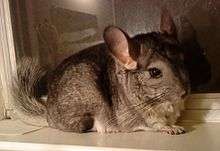
The international trade in chinchilla fur goes back to the 16th century and the animal (whose name literally means "Little Chincha") is named after the Chincha people of the Andes, who wore its soft, dense fur. By the end of the 19th century, chinchillas had become quite rare. In 1923, Mathias F. Chapman brought the eleven wild chinchillas he had captured to the U.S. for breeding.[18] Only three of these were female. Empress Chinchilla is the breeders association for the chinchilla farmers, many of whom are based in the United States, including California. Empress Chinchilla runs a certification program for farmers. [19].
Fox
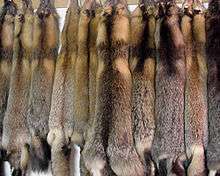
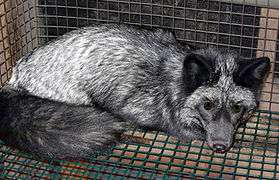
Finland is the world's leading producer of fox pelts. In the United States, fox production is about 10,000 pelts, produced in about 10 states. Canada produces ten to fifteen times as many fox furs as the USA.[20]
Dog and cat
The United States banned the import, export, and sale of products made from dog and cat fur in 2000.[21] Italy, France, Denmark, Greece, Belgium, and Australia ban the import of domestic cat and dog fur but the sale is still quasi-legal.[22] In most countries, novelty items made from farmed cat and dog fur is available in the form of animal toys or as trim on garments like boots, jackets and handbags. The European Union banned imports in 2009.[23]
Rabbit
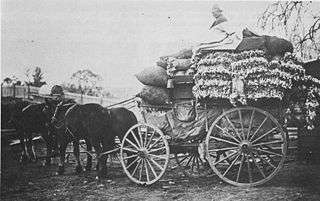
The main breed in the rabbit fur farming industry is the Rex (Castor Rex and Chinchilla Rex). Breeding animals are kept for up to 3 years, and usually give birth twice a year. The kits are taken from their mothers at 4 weeks old and put in a nursery with other kits. After this, the mothers are kept separated from their kits, and they get put together only for feeding. When the kits are 7 to 8 weeks old, they are put in solitary cages, where they are kept for about 6–7 months, and are slaughtered after they have shed their winter fur. The rabbits are kept in bare wire mesh cages. A cage for one rabbit has the floor space of about two shoe boxes. The mortality rate for caged Rex is 10 – 15%, mostly from respiratory disease.[24]
Farmed mink production cycle
Conditioning and breeding (December - March)
During this time of year, ranchers are primarily focused on bringing their selected mink into a good condition that is suitable for breeding. Mink are a monoestrous species that undergo delayed implantation when bred successfully, this means that the breeding season can be the most strenuous time of year both in terms of animal nutrition and human labor.[25] It is essential that management practices employ a feeding program that maintains a nutritional diet that is adequate for both male and female mink. A feeding program that encourages the removal of excess weight and an environment that facilitates an increase in exercise is important for good production and a successful whelp.[26] Mink are usually fed once or twice a day during the growing season; on most farms they are fed the same quantity of food on all cages and close to an ad libitum amount so that 50% of all cages have feed left over the next day.[27] In addition to fur quality and production traits, breeder selection should concentrate on health and temperament (21) to improve the welfare of the herd.[28]
Breeding records are kept for each individual mink, this includes information on the dates of mating, genetics involving family lineage, reproductive success, health status, and fur characteristics.[26]
Whelping and weaning (April - June)
In preparation for whelping, comfortable conditions are prepared for the female by providing ample aspen bedding in which she can create a nest. It is well-known that female mink are highly motivated to perform maternal-related nest building during the majority of their gestation period,[29] this is why providing an abundance of substrate to prepare a nest is crucial to maintain the animals welfare. Unnecessary stress and noises should be avoided so due to the sensitivity of female mink during late gestation. Gestation varies from 40-70 days, this time is often shortened by extending the daylight period by use of artificial lighting.[26]
Females give birth to 5-6 kits on average. Since kits are born altricial, the female spends most of her time in the nest boxes caring for them. Mink kits are fully dependent on the dam's milk and will nurse for the first four weeks of their life.[30] Maternal care is essential to promote offspring survival and growth, particularly in American mink who give birth to altricial young.[31] Ranchers should check them regularly to ensure all the kits are warm, receiving enough milk, and are growing well. Females can lose significant body condition during lactation so their health is monitored by visual observations of behavior, appearance, and feed consumption.[26] Weaning takes place when the kits reach approximately 6-8 weeks old. The changes that take place during weaning can be stressful for both dam and kits therefore is done at a time that is most beneficial for the mother and litter. Ranchers should ensure the kits are able to consume solid feed and drink water independently before they are ready for weaning.[28]
Growth and furring (July - October)
Very rapid growth takes place during the growth phase of the production cycle. For about 10-11 weeks, it is critical that the juvenile kits have access to adequate amounts of feed that is formulated to meet their nutritional needs. Maintaining a feeding routine that allows for multiple distributions of feed a day will help keep feed fresh and encourage appetite.[28] In July, all mink (including kits and adult breeders) are vaccinated to prevent diseases and promote health and welfare of the herd. Once August arrives, the skeletal growth of kits is complete and the subsequent growth of primarily fat begins. The growth of fur predominantly takes place during the fall where it begins at the tail and continues up the back and to the head. Ranchers maintain a clean, healthy environment during this time by performing daily husbandry practices, this includes; cleaning nest boxes, removal of surrounding debris and manure from the barn, bedding the cages, and up-keeping the cleanliness of the facility and farming equipment. Ranchers are diligent toward creating an environment that prioritizes the welfare of each animal and allows them to live and function comfortably within their environment.
Grading and slaughter (November - December)
Mink are carefully evaluated in November or early December in order to physically assess their coat color, characteristics, and quality. Fur quality, along with skin size are two of the most important traits that are under intense selection in most mink breeding programs.[32] Each mink will be given a grade dictated by the attributes of their coat; this is valuable in determining which mink will be kept as breeding stock for next season. Fur quality, color, and body size are judged by the farmer or a professional grader.[33] Fur grades are often used alongside size, weight, health history, parent reproductive success, litter size, and temperament to assess the quality and potential of each animal.[26]
Mink are slaughtered in December and methods are used to euthanize each animal so that their death is quick, humane, and as painless as possible. Several techniques have been considered proper to euthanize farmed mink, these include neck breaking, electricity, carbon monoxide, carbon dioxide, nitrogen, argon, and lethal injection.[34] The most common method of slaughter is by subjecting the animal to a chamber that contains carbon monoxide. Pelting takes place either on site or upon shipping the mink to an offsite operation.[26]
By-products
After pelting, fur farms dispose of their dead animals as economically as possible. The mink bodies are typically sent for either incineration or rendering where they can be converted into bone and meat meal.[35] The meat from most fur-bearers is not usually eaten by humans, therefore the carcasses will go on to become various products such as pet food, animal feed, organic compost, fertilizer, paint, and even tires. Carcasses sometimes go to animal sanctuaries, zoos, and aquariums to feed animals, and some end up as crab bait. Some biological supply companies offer preserved skinned carcasses of ranched mink for classroom dissection specimens as an alternative to cats or other domesticated mammals. Mink feces are used as organic crop fertiliser, and mink fat is turned into oil to manufacture soap, face oils, cosmetics, and leather treatments.[36]
Controversy
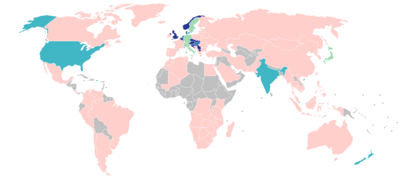
Anti-fur activists have claimed that methods used on fur farms are focused on maximizing profits at the expense of the welfare of fur producing animals.[37][38][39]
As with other types of animal farming, living conditions of animals vary, and extreme cases are of much contention. According to PETA, the majority of fur farmers pack animals into small cages, preventing them from taking more than a few steps back and forth. PETA claims foxes and other animals suffer as a result of the confined environment, and may even cannibalize each other as a reaction to their confinement.[37] In other cases, as with passing of animal welfare legislation in Italy, animals are required to be given enriched living environments in which they can climb on branches, dig holes, use a nest of 50 × 50 cm and also have a water basin of at least 2 × 2 metres and 50 cm deep in which to swim.[40] Farmers argue that 50 years ago, the animals were kept in large outdoor holding areas, with pools of water. However, such farms resulted in high disease rates for the animals and were not practical. Farmers claim that today's farmed animals only know farm life as they have been domesticated through over 100 of years of selective breeding.[41] The methods used for slaughtering the animals on farms and in the wild vary depending on the animal. For farmed mink, the American Veterinary Medical Association researches the best methods and publishes a report on the subject every 7 to 10 years. This report is used to guide state departments of agriculture which have jurisdiction over farm animals, including farm-raised mink. For those harvesting wild furs, biologists and wildlife managers dictate seasons, method of slaughter, and numbers of animals to be harvested.
United Kingdom
After a long campaign of daily protests, an act of parliament was introduced to ban the farming of animals for their fur. Fur farmers were given compensation in England and Wales in 2000. At second reading, the ban in England and Wales was justified principally on grounds of public morality.[40] Prior to the ban, there had been 11 fur farms in the UK producing about 100,000 pelts annually. Respect for Animals Campaign director Mark Glover said at the time: "To keep animals in such conditions in the name of fashion is totally unacceptable in a civilised society."
"We're the first country to introduce a national ban. It is a massive victory for us."
The Bill honoured Labour's pre-election pledge to end fur factory farming.[42] Although the last fur farm in Scotland had closed in 1993, the Scottish Parliament nevertheless banned fur farming in 2002. Fur farming was also banned in Northern Ireland in 2002 under the Fur Farming (Prohibition) (Northern Ireland) Order 2002.[43]
Austria
In Austria, six of the nine federal states have banned fur farming, and the remaining three enforce such strict welfare regulations, in relation to the availability of swimming water, that fur farming is no longer economically viable.[40]
Republic of Ireland
In the Republic of Ireland there are currently three[44] fur farms in operation. These farms focus mainly on the trade of mink fur (some farms which have used fox fur are currently winding down operation as such trade is no longer economically viable). In 2006, approximately 170,000 mink and 300 foxes were harvested in the Republic of Ireland.[45] Furs are exported from the Republic of Ireland to other EU member states or to countries in Asia and North America. In the Republic of Ireland, fur farms are monitored by the Department of Agriculture, and welfare standards of Ireland and the European Union must be adhered to at all times. In October 2009, there were discussions within the political sphere on the banning of fur farms in the Republic of Ireland.[46] Animal welfare groups have welcomed such proposals,[47] though concern has been highlighted, in terms of its impact on rural communities where alternative industries are scarce. Fur farming in the Republic of Ireland contributes about €15 million per year to the economy.[44] A ban was subsequently passed before being overturned by Minister for Agriculture at the time Simon Coveney of Fine Gael after the party formed a new government following the 2011 election. A renewed campaign and efforts to push the Irish government or current Minister for Agriculture Michael Creed to re-implement a phase-out ban took place from 2018 to 2019.[48] Following the introduction of the Solidarity party's 'Prohibition of Fur Farming Bill 2018', the government gave in to political and public pressure and agreed conclusively through Minster Creed to implement a phase-out ban on fur farming in Ireland with the finer details yet to be announced. [49]
Netherlands
Fur farming of chinchillas and foxes is banned. Legislation to phase out mink fur farming (and thereby effectively all fur farming) by 2024 was approved by the end of 2012.[50]
During the COVID-19 pandemic in the Netherlands, by 25 May 2020 there were two cases where minks had infected humans with an apparently mutated form of the virus. There was high political pressure on the Agriculture Minister Carola Schouten to immediately cull all minks to prevent spreading this new version to humans. On 26 May, Schouten decided to wait for the veterinary epidemiological research report of 29 May, and said culling was only to be employed as a 'last resort'. Demands to execute all minks immediately, to prevent a fur farm from restarting operations after having been culled due to COVID-19 infections, and to phase out fur farming earlier than the agreed date of 1 January 2024, were all rejected by the minister as legally impossible.[51] After the testing report was completed, Minister Schouten in early June that 10 mink farms in Brabant and Limburg had to be culled to prevent the spread of the coronavirus. An objection from two animal activist groups was overruled by the court. On 6 June 2020 the culling of around 1,500 mother minks with about 4 to 5 pups each at a farm in Deurne was commenced, later 9 others would follow in Milheeze (two), De Mortel, Elsendorp, Beek en Donk, Deurne, Landhorst and Venray.[52]
China
.jpg)
In 2005, animals rights group The Swiss Animal Protection produced a controversial video reporting that fur-bearing animals - including the "Asiatic raccoon" (raccoon dog) - were being skinned while still alive in Shangcun Market.[53][54] The China Fur Commission and China Leather Industry Association challenged the authenticity of the video, stating: "Pictures showing animals being skinned alive are obviously plotted. All those with common sense would not choose this slaughter method to attain fur."[55] The government of Suning County, Hebei Province also issued a statement, outlining welfare practices it claimed to practice on its fur farms and calling the alleged practice of skinning animals alive "unimaginable."[56] Swiss Animal Protection later published a video showing the live skinning of raccoon dogs and other canids. The video shows raccoon dogs being beaten with sticks and thrown against the ground in an attempt to stun them before being hung from their rear legs and skinned alive. In another film a worker begins to cut the skin and fur from an animal's leg. The animal is still alive breathing and kicking. The free limbs kick and writhe making it difficult for the worker to cut the skin from the animal's body. The worker stamps on the animal's neck and head. One investigator filmed a raccoon dog being skinned alive before being thrown onto a heap of carcasses. After the skinning the animal still had enough strength to lift its bloodied head and stare into the camera.[57] A 2013 investigation by a Dalian-based Chinese animal welfare group reported similarly cruel practices at various fur farms in Liaoning province.[58]
In 2006, the State Forestry Administration (SFA) announced it was planning to offer training courses for fur farmers to improve the living conditions of fur animals.[59] Legislation was drafted in September 2009 to address any cruelty to animals in China. If passed, the legislation would regulate how farm animals are raised, transported, and slaughtered.[60]
Finland
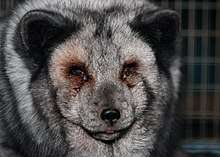
Finnish citizens have had a right to instigate parliamentarian law initiatives since 2012. The first citizens' initiative to gain enough signatures was that instituting a ban on fur farming. Some 70,000 citizens signed the initiative within the required time period in 2013.[61] In a march to Parliament House, Helsinki on 18 June.[62], four to five hundred people appealed to members of parliament to approve the citizens' initiative to ban fur farming. According to animal expert MSc Sesse Koivisto (wife of Ilkka Koivisto ex-director of the zoo Korkeasaari) in Helsingin Sanomat in 2010, fur farming did not provide acceptable conditions for the animals. In order to stop the suffering of animals, she demanded a ban on fur farming in Helsingin Sanomat, as in some other countries.[63] On 19 June 2013, the Finnish Parliament rejected the first citizens' initiative to ban fur farming. A positive development in the politics of Finland was that the initiative was taken in the Parliament for public voting.[64][65]
In Finland in August 2016, there were about 950 active fur farms. The breeding of fur-animals has had a long tradition in Finland, having been professionally conducted since the 1920s. Up to 90% of the fur-farming community is situated in the rural areas of Ostrobothnia and employs four to six thousand people. Today, fur farming is strictly regulated by law. The Finnish Furbreeders Association has developed its own national program of certification and animal health welfare that is tied to the ISO 9001 standard and monitored by the Norske Veritas. The fur animals are housed in shelter buildings or halls, where each animal has a specific place marked with a kit card. Shelter buildings are suitable for all fur animals, but halls are only used in mink farming.
Estonia
Estonian citizens have a partial right to submit initiatives with at least 1000 signatures to the parliament since 2014. They do not directly go to the parliamentary hall but go through a process of review in a subject commission.[66][67] On November 21, 2014, the Estonian animal advocacy organization Loomus submitted a petition to ban fur farming in the country with a 10-year transition period with 10 000 signatures to the parliament.[68][69][70][71] This was preceded by secretly filmed anonymous documentary footage being aired both online via YouTube and on Estonian National Television[72] depicting the conditions of the animals in 2012 (aired 2013) and 2014.[73][74][75] The Estonian animal advocacy organization Loomus issued a comment after the airings of Estonian Public Broadcasting outlining the documented disregard animal welfare regulations and pointing out the numerous injuries of animals that were documented.[75][76]
The petition has since been under review in the commission of agricultural affairs.[77] The commission procured a study on the economic significance of the industry from the Estonian University of Life Sciences published in 2016, which did not state the exact number of farms in existence but did outline that the mink and fox farms employed 74 full-time workers in 2014, with the majority concentrated in the largest factory in the Baltic States, in Karjaküla, near Tallinn.[76][78] It also reported the chinchilla farms employed 20.5 full-time workers in 2014.[78] The activists have voiced their concern about the bias inherent in the study, which according to them by and large ignored ethical and environmental arguments, as a number of the experts in the study panel were found to have direct links to and vested interests in the fur industry.[79] The commission is expected to formulate their opinion and vote whether the petition would move on to a law drafting phase and public discussion in the full quorum of the parliament in the fall of 2016.[77][80]
On August 22, 2016, activists launched an additional international petition inviting the Estonian Parliament to ban fur farming in the country at change.org.[81]
Canada
Quebec
In 2014, for the first time in Canadian history, a Quebec fur farmer by the name of Jean-Luc Rodier was charged with animal cruelty following an investigation by the Society for the Prevention of Cruelty to Animals (S.P.C.A.). Fox and mink at the fur farm were seized by animal welfare organizations and some were in such poor condition that they had to be euthanized.[82] Following the S.P.C.A. investigation, this Quebec fur farm was raided by anonymous activists who set free thousands of animals.[83]
British Columbia
Video footage taken at fur farms in 2014 in British Columbia by the A.P.F.A.[84] was described by the S.P.C.A. as "inherently inhumane".[85] Animal rights activists in the city of Vancouver have been using legal and illegal actions to protest selling fur such as vandalism, home demonstrations of fur shop owners, and organizing public protests.[86]
Ontario
Canadian fur farms in the Province of Ontario have been repeatedly targeted by the Animal Liberation Front (ALF). Thousands of mink were freed from farms across the province during 2013[87] and 2015.[88] The mink breeders association of Ontario responded by offering a hundred thousand dollar bounty leading to a conviction of the persons responsible.[89] Undercover footage was also released by the ALF in 2015 of several Ontario area mink farms, showcasing injured animals and mink cages covered in feces and maggots.[90] Animal rights organizations across the province have taken a wide array of actions to stop the fur trade, such as public protests and disruptions of fur fashion shows.[91][92]
See also
- Environmental impacts of fur farming
- Fur
- Fur trade
- Factory farming
- Leather
- Tanning
References
- Sustainable Fur. (2017). Europe: Regulations. Retrieved from https://www.wearefur.com/responsible-fur/farming/fur-farming-europe/. Accessed on November 24th, 2018.
- International Fur Trade Federation. "The Socio-Economic Impact of International Fur Farming" (PDF). Archived from the original (PDF) on 13 July 2011. Retrieved 7 May 2009.
- US Mink: State of the Industry – 2011. Furcommission.com. Retrieved on 10 May 2012.
- "Industry & Trade Summary – Jan 2004" (PDF).
- "What are the rules on wearing fur?". BBC News. 12 January 2006. Retrieved 24 March 2008.
- Charles Clover Europe kicks up a stink over British move to ban mink, Telegraph.co.uk, 13 May 1999
- Fur Farming Legislation Around The World, Infurmation.com
- Fur Farmers Backed into a Corner, fashionFINLAND.com, 2 January 2007
- MPs vote to ban fur farms. BBC News, 22 November 2000. Retrieved on 10 May 2012.
- Fur Farming (Prohibition) (Scotland) Act 2002. legislation.gov.uk. Retrieved on 28 May 2012.
- "Czech Fur Farming Ban Signed by President Zeman". Fur Free Alliance. Fur Free Alliance. 5 August 2017. Retrieved 10 August 2017.
- "Norway to ban fur farms as fox, mink go out of fashion". Straits Times. Straits Times. 15 January 2018. Retrieved 15 January 2018.
- {{cite news|url=https://www.nytimes.com/1991/02/26/business/fur-industry-shrinking-with-no-end-in-sight.html%7Ctitle=Fur Industry Shrinking With No End in Sight|first=John F.|last=Burn|publisher=New York Times|date=February 26, 20
- "Fur Industry". MSN Encarta. Archived from the original on 24 March 2008. Retrieved 24 March 2008.
- Journal, Rosanna TamburriStaff Reporter of The Wall Street (24 December 1996). "Prices Rise in Fur Industry After Dropping in Late 1980s" – via www.wsj.com.
- Guidelines on Euthanasia. (PDF). avma.org. Retrieved on 4 December 2012.
- Nova Scotia Mink Breeders Association. (2016). "Mink Farming: Quick Facts". Retrieved from https://nsmink.ca/index.php/mink-farming
- "Chapman Story". Edchinchillas.co.uk. Retrieved 23 February 2017.
- "Home". Empress Chinchilla.
- Audrey Eggers. "Farming For Fur". adapted from an article in the August/September 2002 issue of AgVentures. Fur Commission USA. Archived from the original on 21 July 2011. Retrieved 24 March 2008.
- The trade in dog and cat fur, Happy Paws
- "Betrayal of Trust: the Global Trade in Cat and Dog Fur". Humane society. Archived from the original on 21 March 2008. Retrieved 26 March 2008.
- Kerasote, Ted (24 March 2008). "An Olympic disgrace". Archived from the original on 1 February 2009. Retrieved 26 March 2008.
- "Rabbit fur: face the facts". The Coalition to Abolish the Fur Trade (CAFT). Retrieved 28 March 2008.
- Felska-Błaszczyk, Lidia; Ławrów, Natalia; Lasota, Bogdan; Seremak, Beata; Pęzińska-Kijak, Katarzyna; Żuk, Krzysztof; Nowak, Piotr (7 September 2018). "The sex ratio in farmed American mink (Neovison vison)". Archives Animal Breeding. 61 (3): 359–363. doi:10.5194/aab-61-359-2018.
- Canada Mink Breeders Association.(n.d.). "A Year on a Mink Farm". Retrieved from (http://canadamink.webtext.ca/cmbfarm.shtml Retrieved on November 22nd, 2018.
- Hansen, Steffen W.; Møller, Steen H. (May 2008). "Diurnal activity patterns of farm mink (Mustela vison) subjected to different feeding routines". Applied Animal Behaviour Science. 111 (1–2): 146–157. doi:10.1016/j.applanim.2007.05.020.
- National Farm Animal Care Council.(2013). "Code of Practice: For the Care and Handling of Farmed Mink". Retrieved from (http://canadamink.webtext.ca/2013-06_Mink_Code_of_Practice.pdf Retrieved on November 22nd, 2018.
- Schou, Toke Munk; Palme, Rupert; Malmkvist, Jens (October 2018). "Prolonged nest building increase the reproductive outcome in American female mink". Applied Animal Behaviour Science. 207: 98–107. doi:10.1016/j.applanim.2018.07.005.
- Brink, A.-L.; Jeppesen, L.L.; Heller, K.E. (November 2004). "Behaviour in suckling mink kits under farm conditions: effects of accessibility of drinking water". Applied Animal Behaviour Science. 89 (1–2): 131–137. doi:10.1016/j.applanim.2004.06.007.
- Schou, T. M.; Malmkvist, J. (20 February 2017). "Early kit mortality and growth in farmed mink are affected by litter size rather than nest climate" (PDF). Animal. 11 (9): 1581–1589. doi:10.1017/S1751731117000234. PMID 28215201.
- Thirstrup, J.P.; Jensen, J.; Lund, M.S. (August 2017). "Genetic parameters for fur quality graded on live animals and dried pelts of American mink (Neovison vison)". Journal of Animal Breeding and Genetics. 134 (4): 322–331. doi:10.1111/jbg.12258. PMID 28295659.
- Lagerkvist, Gabrielle (February 1997). "Economic profit from increased litter size, body weight and pelt quality in mink (Mustela vison)". Acta Agriculturae Scandinavica, Section A. 47 (1): 57–63. doi:10.1080/09064709709362370.
- Korhonen, Hannu T.; Cizinauskas, Sigitas; Jesernics, Janis (1 September 2012). "Electrophysiological study on co and co2 euthanasia in mink (Mustela vison)". Annals of Animal Science. 12 (4): 597–608. doi:10.2478/v10220-012-0050-2.
- Zarkadas, I.; Dontis, G.; Pilidis, G.; Sarigiannis, D.A. (October 2016). "Exploring the potential of fur farming wastes and byproducts as substrates to anaerobic digestion process". Renewable Energy. 96: 1063–1070. doi:10.1016/j.renene.2016.03.056.
- "Fur Farming". montanatrappers.org. 2014. Archived from the original on 2 April 2004. Retrieved 4 December 2014.
- "Inside the Fur Industry: Factory Farms". PETA. Retrieved 11 July 2017.
- "Frequent Reasons for buying Fur". fur.elehost.com. Archived from the original on 12 March 2008. Retrieved 24 March 2008.
- "House of Commons Hansard Debates for 5 Mar 1999 (pt 6)". 5 March 1999. Retrieved 24 March 2008.
- "Support Our Efforts for Animal Rights". Bont voor Dieren. Archived from the original on 15 December 2005. Retrieved 29 December 2005.
- www.fureurope.eu (PDF) https://www.fureurope.eu/wp-content/uploads/2015/09/Domestication-and-Natural-Behaviour-of-the-Farmed-American-Mink.pdf. Retrieved 10 January 2019. Missing or empty
|title=(help) - "Campaigners hail fur ban bill". BBC News Online. 22 November 2000.
- "The Fur Farming (Prohibition) (Northern Ireland) Order 2002". Legislation.gov.uk. HM Government. Retrieved 12 March 2017.
- "The mink behind the wire: Inside Ireland's fur farms".
- Compassion In World Farming Ireland – Irish Farming Facts. Ciwf.ie. Retrieved on 10 May 2012.
- "Plan focuses on electoral reform, education spend". The Irish Times. 10 October 2009.
- "Animal welfare groups welcome ban on fur farming". The Irish Times. 10 October 2009.
- . rte.ie. Retrieve on 14 March 2018
- . The Journal. Retrieve on 24 June 2019
- "Dutch law will ban mink farming by 2024". Daily News and Analysis. Reuters. 18 December 2012. Retrieved 26 December 2012.
- ANP (26 May 2020). "Schouten: in uiterste geval alle nertsen ruimen". NOS (in Dutch). Retrieved 26 May 2020.
- Ties Cleven, Ad de Koning (6 June 2020). "Nertsenbedrijf in Deurne als eerste geruimd: 'Dit is voor ons ook nieuw'". Brabants Dagblad (in Dutch). Retrieved 6 June 2020.
- Dogs and Cats Skinned Alive for Their Fur in China. The Epoch Times (21 February 2007). Retrieved on 23 December 2013.
- A Shocking Look Inside Chinese Fur Farms. PETA.org. Retrieved on 23 December 2013.
- Announcement by China Fur Commission, China Leather Industry Association. china-embassy.ch (4 March 2005)
- Statement from The People's Government of Suning County Archived 24 December 2013 at the Wayback Machine. Old.furcommission.com (22 April 2005). Retrieved on 10 May 2012.
- "China accused of skinning live animals for fur [graphic video] (Includes interview)". Digitaljournal.com. 2 May 2010. Retrieved 22 February 2017.
- "VShine Animal Protection Association: Fur Survey". Archived from the original on 18 May 2015. Retrieved 23 August 2019.
- "Regulations to Improve Wildlife Welfare".
- "China unveils first ever animal cruelty legislation". The Daily Telegraph. London. 18 September 2009. Retrieved 18 September 2009.
- Parliament mulls how to deal with citizens’ initiatives yle.fi. 13 March 2013
- 100s march against fur farming. yle.fi 18 June 2013
- Kurjuuden ylistys. vuodatus.net. 27 February 2010
- Parliament says no to fur-farming ban Parliament says no to fur-farming ban. yle.fi. 19 June 2012
- Turkistarhauksen kielto kaatui äänin 146-36. yle.fi 19 June 2012
- "Response to Memoranda and Requests for Explanations and Submission of Collective Addresses Act – Riigi Teataja". www.riigiteataja.ee. Riigi Teataja. Retrieved 31 August 2016.
- "Riigikogu Rules of Procedure and Internal Rules Act – Riigi Teataja". www.riigiteataja.ee. Riigi Teataja. Retrieved 31 August 2016.
- "PN Ekstra: Loomaõiguslaste südantlõhestav salavideo". Estonian Public Broadcasting. Archived from the original on 3 October 2016. Retrieved 31 August 2016.
- "Loomakaitsjad annavad riigikogule üle 10 000 karusloomafarmide keelustamise toetaja allkirja | Lääne Elu". Lääne Elu. 17 November 2014. Retrieved 31 August 2016.
- "Over 10,000 signatures given to ban fur farming". Estonian Public Broadcasting. 17 November 2014. Retrieved 31 August 2016.
- "Aita keelustada karusloomafarmid!". petitsioon.ee. Retrieved 31 August 2016.
- "Eesti naaritsafarmid tegutsevad aastaid loata". Pealtnägija, Estonian Public Broadcasting. 17 April 2013. Retrieved 31 August 2016.
- "Loomaõiguslaste salavideo näitas karusloomakasvatuse telgitaguseid". Estonian Public Broadcasting. 19 November 2014. Retrieved 31 August 2016.
- "Karusnaha lugu". Loomade Nimel/In the Name of Animals. 5 November 2014. Retrieved 31 August 2016.
- "Press release: Undercover footage exposes the Estonian fur industry once again". Loomade Nimel/In the Name of Animals. 20 November 2014. Retrieved 31 August 2016.
- "Video of Fur Farm Operating Without License Provokes Outrage". Estonian Public Broadcasting. 18 April 2013. Retrieved 31 August 2016.
- "Padar: maaelukomisjon otsustab karusloomakasvatuste saatuse kiiresti". Postimees. Archived from the original on 11 September 2016. Retrieved 31 August 2016.
- "Final Report - A Study on Fur Farming (in Estonian)" (PDF). Estonian University of Life Sciences. 29 January 2014. Retrieved 31 August 2016.
- "Animal advocates: Impact analysis on fur farming is biased". loomus.ee. Animal Advocacy Organization Loomus. 3 May 2016. Retrieved 31 August 2016.
- "Maaelukomisjon otsustab karusloomakasvatuste saatuse võimalikult kiiresti". Estonian Public Broadcasting. 25 July 2016. Retrieved 31 August 2016.
- "International petition calls on Estonia to ban fur farms". loomus.ee. Animal Advocacy Organization Loomus. 22 August 2016. Retrieved 31 August 2016.
- "A Quebec first: Fur farm owner charged with cruelty, negligence | CTV Montreal News". Montreal.ctvnews.ca. Retrieved 22 February 2017.
- "Quebec farmed mink set free by intruder - Montreal - CBC News". Cbc.ca. 20 August 2014. Retrieved 22 February 2017.
- "Make Fur History | The Fur Bearers". Furbearerdefenders.com. 29 October 2014. Retrieved 22 February 2017.
- "Footage released from B.C. mink farms is 'horrifying' says BC SPCA". Globalnews.ca. 30 October 2014. Retrieved 22 February 2017.
- "Summary of Anti-Fur Action in Vancouver | Vancouver Media Co-op". Vancouver.mediacoop.ca. 13 January 2013. Retrieved 22 February 2017.
- nurun.com (27 August 2013). "Fox, mink sprung from fur farm | Simcoe Reformer". Simcoereformer.ca. Archived from the original on 20 November 2015. Retrieved 22 February 2017.
- nurun.com (31 July 2015). "Another mink farm hit | The London Free Press". Lfpress.com. Retrieved 22 February 2017.
- Steve Rice (4 June 2015). "Hefty reward offered to catch perpetrators of deadly mink release | Ontario | Ne". Torontosun.com. Retrieved 22 February 2017.
- "BITE BACK Magazine". Directaction.info. Retrieved 22 February 2017.
- "Protester Crashes Runway At Toronto Fashion Week". Huffingtonpost.ca. 27 March 2015. Retrieved 22 February 2017.
- "Anti-fur advocates protest at Channer's | CTV London News". London.ctvnews.ca. 15 February 2014. Retrieved 22 February 2017.
External links
| Wikimedia Commons has media related to Fur-farming. |
- Fur is Green – Fur Council of Canada
- A Brief History of the Fur Trade – White Oak Society
- The Fur Industry – MSN Encarta (another archive)
- *Information on Finnish Furfarming

